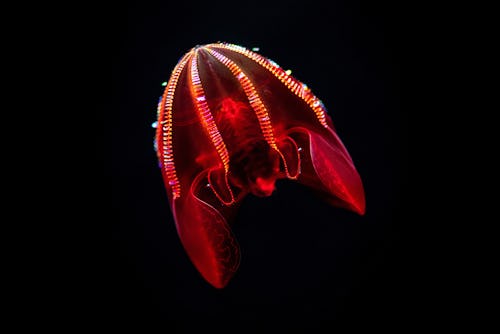
We all know that unicorns poop glitter. Of course, we also all know that unicorns don’t exist. But you know what does exist? The bloody-belly comb jellyfish. And you know what this deep sea invertebrate does? That’s right, it poops glitter.
The bloody-belly comb jelly, otherwise known by its scientific name of Lampocteis, is one of those creatures that has likely lived in the ocean completely unbothered by humanity until about 20 years ago, when it was spotted during a remote excursion conducted by researchers at the Monterey Bay Aquarium Research Institute.
Now, for the first time ever, it is on display at an aquarium in the United States, living at the Monterey Bay Aquarium in Monterey, California, as part of the new Into the Deep exhibit. And, given that it’s the first time the jellyfish has been chilling in a captive environment, we’re starting to learn much more about the creature. For instance: what its poop looks like.
Under most circumstances, it’d be strange to be so obsessed with what comes out of a creature’s exit hole — and, frankly, it’s weird in this case, too. But it’s not every day that we run into an animal that leaves a trail of glitter everywhere it goes. It almost makes the idea of swimming in its filth seem charming. Almost.
You’d think, for a creature that lives so deep in the ocean that most light doesn’t reach it, it’d be a bit of a risk for something to not only poop glitter but also have a glowing red body. But according to Monterey Bay’s researchers, the red actually blends into the darkness down below, so the jelly largely goes unnoticed by predators. That makes the trail of glitter almost audacious, as if it’s daring other undersea creatures to notice it.
If you have the opportunity, you should go see the bloody-belly comb jelly on display in Monterey. You don’t have to hang around long enough for it to unleash a glitter bomb, but considering your other opportunity to see this thing would require you to go 3,000 feet under the ocean’s surface, you may want to take this chance instead.







